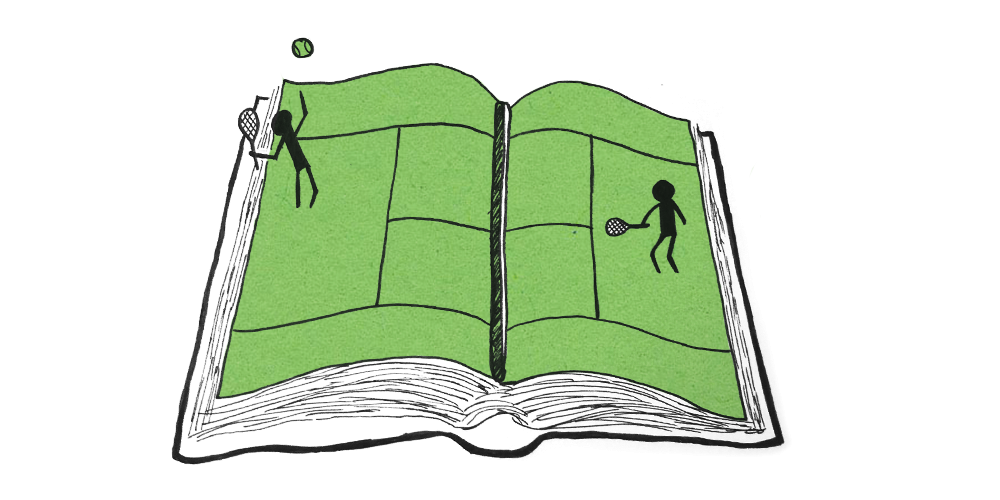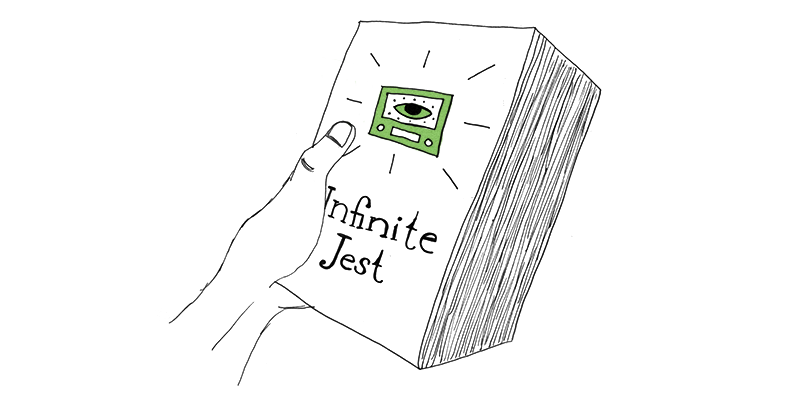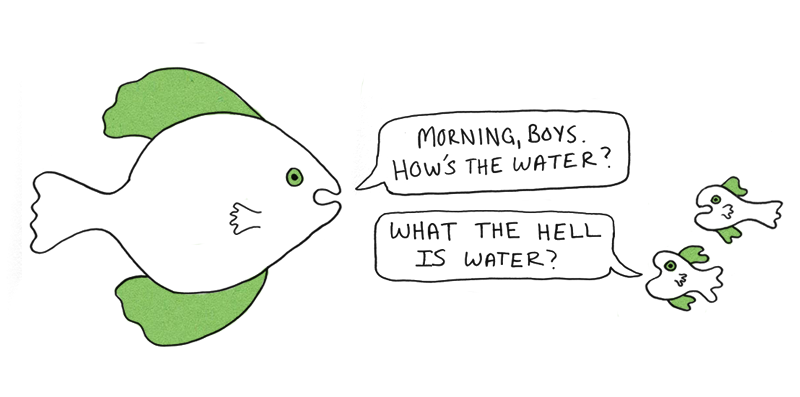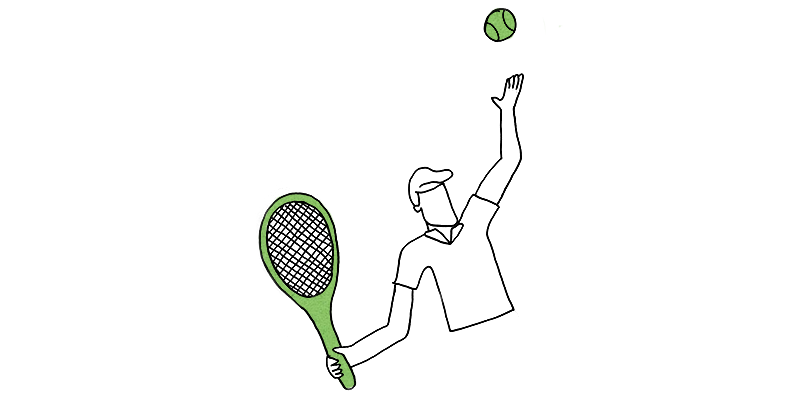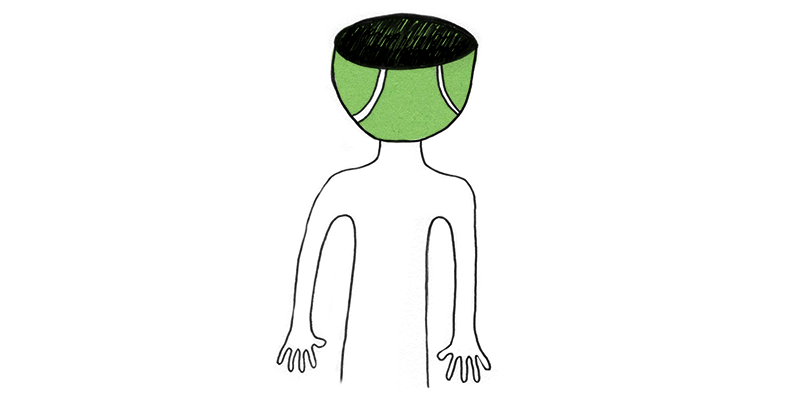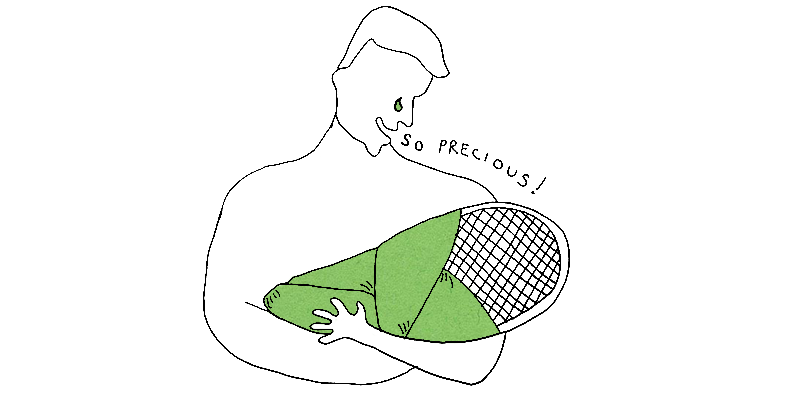“Hey,” I say, and pause for a moment, slinging my tennis bag over my shoulder and closing the car door. I start down the grassy slope toward the tennis court. It is my opponent I have called out to, inside the fence. I swing the gate open and let it clang behind me. Now, I shuffle a little on the court, to hear the clay beneath my shoes. The court waits for us, swept of any previous play. We are ready to begin.
The way I imagine it, we are at the Highland courts, a short drive from my home. The Highland courts are a set of four natural red clay courts at the edge of a forested town park, right next to a somewhat secluded neighborhood of Victorian houses from the town’s factory heyday. We are alone, he and I, perhaps in the early morning. He has something of a blank look on his face, dressed not a little uncomfortably in a set of what looks like Wimbledon whites, except not so bright, rumpled even. But he has on his trademark head rag, tying back his hair.
Maybe there is small talk, as we unpack our bags. The weather, or when was the last time each of us played. Does he want to warm up short, standing on the service line and trading easy half volleys? In the kind of tennis I play, the adult recreational kind, there is a certain unease to begin, a mix of friendly get-to-know-you banter with an overlay of the what-sort-of-opponent-will-you-be subtle interrogation. Perhaps this is not unlike sizing up a new book, or maybe even moreso for a book whose reputation, at this point, certainly precedes it.
I started reading David Foster Wallace’s 1 signature novel, Infinite Jest, in December 2015. I was a little surprised to receive it as a Christmas present, from what I thought was an unlikely source — my in-laws 2. But it turns out that I had mentioned the book in my Christmas Elf letter, almost in passing, as I was trying to think of things to put on my list. The point is that it is a modest list — I often ask for t-shirts from craft breweries where my brothers live — and a book was an afterthought. The book has loomed in my consciousness for some time, but I’ve only come to seriously consider reading it, and in fact to actually read it, because of tennis.
I was aware of Wallace 20 years ago, in the fall of 1996, when I arrived in Amherst, Massachusetts, to study at UMass in the university’s somewhat famed MFA in Creative Writing program 3. I was a poet, not a fiction writer, but I was aware of Infinite Jest as having the reputation of being the sort-of “Ulysses of our generation,” a book that was known by all to be a work of genius, but also difficult and quite long, so reading the book was an undertaking few would actually complete. I remember coming away from the first social event in the lounge of Bartlett Hall 4 thinking that I was woefully underprepared, in terms of the reading I had done up to that point. But as a poet, reading Infinite Jest wouldn’t be on my to-do list. Instead, I had to figure out who this John Ashbery guy was, and what the heck Language poetry was.
Four years later, with a better grasp of Ashbery (but still somewhat baffled by Language poetry), I finished my MFA and went into journalism — and by “journalism” here, I mean I got a job as a reporter at the daily newspaper in the small town where I live. I started to get interested in nonfiction. Along the way, I read some of Wallace’s magazine pieces, like the one he did on talk radio (“Host” in The Atlantic), and the one on Webster’s Third (“Tense Present” in Harper’s), where he explored lexicography and the divide between the prescriptivists and the descriptivists. These magazine articles were brilliant. Here was a guy who was obviously smart 5, but what really intrigued me was the way he followed his diverse and sometimes esoteric interests, dove deeply into them and explored them — and explained them in an engaging way. As I was making the move from a daily newspaper to a weekly, and trying to write magazine-y pieces, I really saw what Wallace was doing as a model. I thought of magazine writing as working with layers, so that you would weave together first-hand reporting with back stories and larger thematic material. I saw Wallace able to zoom in to describe his subjects with precise detail, and also seamlessly pan back out and explain concepts with an eye to the big picture.
It wasn’t until later — when I had been given the corporate boot from my journalism job and my wife and I wound up with a house 6 — that I happened upon the tennis court. Actually, the five tennis courts that were two blocks from our new house 7, courts that I would end up walking by a lot. They were natural red clay courts, and they pulled me back into tennis, a game that — contrary to what my father keeps telling people 8 — I had played when I was a kid, and I played with my buddies in high school, but that I hadn’t really kept up with. But it is a game that now, as a middle-aged adult, I would take up with a passion.
Meanwhile, I started teaching as an adjunct instructor at a local college. I found myself teaching Wallace’s “This is Water” essay 9 to my students, as part of a unit on the value of higher education. I liked using the Wallace essay for the “movies of the mind” exercise, where I reveal a small snippet of the essay — the title first, then the first sentence, then the first paragraph, then the first page, etc. — and project it for them on a screen in front of the room, then have them write in response to just that small snippet, then we talk about it, then we go to the next one. What’s great about Wallace in this essay, is that you can see him move, you can see him double back, change direction. He’s very intentional with what he’s doing. And I always end up talking to my students about how you can sense the author here looking at you the reader, anticipating what you’re thinking. That in some way, as we sit there in that room, looking up at the words projected on the screen, we can see the act of reading (and of writing) as a text suspended like a screen between a reader and an author. On our side, as readers, we try to construct meaning from the words we see and guess at the author’s intentions on the other side. In Wallace, you get a sense of an author who’s palpably there on the other side of the screen, also guessing at us. Maybe you can see where I’m going with this.
It’s often said that the act of reading Infinite Jest is like watching a tennis match, because of the voluminous endnotes. So a good piece of advice when you start out reading Infinite Jest is to get two bookmarks – one to keep your place in the text itself, and then a second to keep your place in the hundreds of endnotes (some with material that’s quite consequential to the narrative of the novel) at the back of the book. So that in reading the book, you keep having to flip from one bookmark to the other, back and forth, back and forth, like a spectator at a tennis match.
But what I found is that the act of reading Infinite Jest is like playing in a tennis match, with Wallace on the other side of the net. And I realize that’s all the more haunting because of Wallace’s suicide in 2008, not too long after giving that famous “This is Water” commencement address at Kenyon College. So that reading Infinite Jest is like playing tennis with a ghost. Reading the Kenyon speech has a haunting feeling to it as well, because Wallace writes about the liberal arts education as a stay against the terrors of ordinary life, and about suicide as killing the terrible master of the head. Moreover, the older fish/younger fish story that Wallace leads with in that essay appeared earlier in Infinite Jest, told in the context of an Alcoholics Anonymous meeting, between recovering addicts.
The essay that perhaps really set me on a collision course with the novel is “String Theory,” a piece that Wallace did for Esquire about the tennis player Michael Joyce. It’s not as famous as his profile of Roger Federer, “Both Flesh and Not,” but I think the deep dive into world of ATP qualies at the Canadian Open is actually Wallace’s best writing on tennis. I had my sports journalism students read it — they’re pretty game when it comes to the eclectic reading I throw at them, even if it is about a minor sport like tennis and written by a non-sportswriter like Wallace. And I also used it once with my freshman composition class, counter-posing it with a Malcolm Gladwell essay on performance-enhancing drugs in sports. Wallace considers what it means to be the 100th best in the world at something — anything — and how impressive that is, and yet how, in tennis, obscure it is 10. To my students, the novelist David Foster Wallace is just as equally obscure as Michael Joyce, former 100th best in the world tennis player. But I have them look up Michael Joyce in Wikipedia and then look up David Foster Wallace, and they see that one of the biggest claims to fame Joyce has is to have been mentioned in Wallace’s tennis article 11.
What’s odd to me is to try to appreciate Wallace’s level of relative fame. After I started reading Infinite Jest, I heard about the film The End of the Tour, which, by the time I had heard of it, was already out on DVD about a year from its theatrical release. I searched for it in the database of my local library, figuring I could get it on interlibrary loan, and saw that my library had it — three copies of it. I was there with two librarians helping me and expressed surprise about the DVD’s presence 12 and they shamed me for thinking an indie think piece film about an author famous for writing the era’s most difficult novel would be anything less than a hot item.
Coming as I have into reading the novel through my interest in tennis, it seems hard for me to imagine how anybody without an intimate knowledge of tennis could understand the novel 13. I often hear it described as if tennis were just a casual part of the backdrop. Readers of Infinite Jest will remember — is how I think the line, or something like it, goes — that the novel is partially set at a junior tennis academy. But that seems to me to radically undersell the underlying importance of tennis to the novel.
As an example, I recall the part of the novel where Steeply, a male secret agent who is posing as a female magazine writer, is sitting watching a tennis match at the just-alluded to tennis academy. Steeply is involved in a conversation with DeLint, an academy higher-up. She refers to tennis as “chess on the run” which is placed in quotes within quotes, because it ostensibly refers to something academy headmaster Gerhart Schtitt said, though not to Steeply. It is a quote I’ve heard attributed to the book (or at least to Wallace) before, by tennis commentators, usually just to note how tennis is a combination of physicality (“on the run”) and strategy (“chess”). 14
But what’s fascinating about Wallace is how intricately he describes the action of tennis, just a page earlier. “Hal Incandenza’s first serve was a tactically aggressive shot but not immediately identifiable as such,” Wallace writes, launching into a paragraph that analyzes the matchup unfolding down on the academy court with Steeply watching. In the paragraph, Wallace describes a point shot-by-shot in minute detail: “Hal’s pivot foot moved him right so he could take it on the forehand, another looper dripping with top, right back in the same corner he’d served to, so that Stice had to stop and spring back the same way he’d come.” But he also describes how to hit a topspin (or “kick”) serve, and muses on the difference between Hal’s game style (counter puncher) and Stice’s game style (power baseliner).
When people talk about Wallace as perhaps the best writer on tennis ever, it’s this ability to see the Matrix-like action of tennis, slow it down to frame-by-frame and tell you what’s happening and why. In “String Theory,” he talks about Joyce in the development of the power baseliner in the men’s tennis game, the top proponent of which, at the time, was Andre Agassi, a player for whom Wallace in the article didn’t even try to contain his evident distaste. But this explanation of how the pro game of tennis has evolved from the serve-and-volley days into its modern form was quite revelatory for me. Especially since tennis as a sport seems to lack this kind of self-conscious analysis within its own ranks. Interestingly enough, another tennis writing touchstone for me was Agassi’s ghostwritten autobiography, Open. 15 Agassi doesn’t ever get as detailed in his description of points, but his rumination of the mental side of tennis, the inner struggle of tennis, seem right up Wallace’s alley.
In “String Theory,” Wallace writes about the idea he had that he might hit with Joyce, an idea he abandoned when he realized what Joyce’s place in the tennis hierarchy meant, up close and court side, compared with his own ability. He writes about how watching tennis on television distorts our view of what’s actually happening in a professional match, a distortion that becomes apparent when you see professional-level tennis played live, right there in front of you, especially at court side, as opposed to up in a grandstand. Which for me is an interesting commentary on the nature of sport and its place in our society. Wallace writes that the notion that he might actually pick up a racket and trade strokes with Joyce came to seem obscene to him.
But it’s that notion that I find so very attractive. That tennis is this activity that could place an author like David Foster Wallace there inside the fence with me. That for all the notion of brilliance, he is (or, at least was) a body, a mere mortal. Unlike, in a way, how he portrays Roger Federer, an icon whose brilliance at tennis can almost convince one of the existence of the divine (thus the title of Wallace’s essay, “Both Flesh and Not”). But in the realm of contemporary American fiction, Wallace’s genius status is positively Federer-esque. 16
In his interview on the National Public Radio program, Fresh Air, Wallace was quite keen to disabuse Terry Gross of the idea that he was a junior tennis player of national talent, though she thought it an apt part of his biography to mention. But something else that Wallace said in that interview has always stuck with me. He relates his tennis coach telling him, “You’ve got a bad head, kid.” What the coach meant was that the young Wallace was unable to quiet his mind, to stop thinking about what might happen on the tennis court, what winning or losing a point might lead to, all the permutations that take you away from the necessary attention on the present, on performance. But it’s hard not to read that line and hear the echo of Wallace’s own suicide, and the subsequent revelations about his struggle with depression. And doubly so not to think of James O. Incandenza, the departed father of Infinite Jest, who stuck his own head in a microwave after creating a film so toxically pleasurable, it saps anyone who views it of their will to do anything else but spectate.
Wallace describes Incandenza in the novel as having been a junior tennis player himself, and in a flashback scene we hear an extended monologue Incandenza’s own father delivers to him critiquing the Cartesian notion of the mind-body duality.17 The key line is perhaps this: “Son, you’re a body, son.” The father here delivers the “hard news” to his ten-year-old son as a way of preparing him to be a tennis prodigy. The mind? “It’s just neural spasms, those thoughts in your mind are just the sound of your head revving . . . ” This is pretty hard core existential materialism. “A tennis ball is the ultimate body, kid,” the elder Incandenza tells the son. “Perfectly round. Even distribution of mass. But empty inside, utterly, a vacuum.”18 This idealization of emptiness contradicts what we come to expect about Wallace, the author. Many people profess to appreciate Wallace because, with his maximalistic prose and tendency toward metacommentary, he writes with an uncanny awareness of an active inner life.
That’s certainly something I appreciate about Wallace’s work. As I made my way through Infinite Jest, I thought about all the basic ways that it is difficult. It’s long: that’s the most obvious. But also, it carries on half a dozen or more primary plot lines, with a large cast of characters, set in a speculative near future and the structure of the novel is not immediately apparent, but takes shape by accretion. Did I mention that it enfolds in a nonlinear fashion, and Wallace hides the timeline behind the running joke of corporate-sponsored “subsidized time”? I can see how reading the novel would seem daunting. But like the complexity by which Wallace describes a tennis match — with the geometry, angles, strategy, and movement — the pleasure in reading Infinite Jest comes when you start to get it, when you begin to see the parallel courses of the different plot lines and ideas, when you start to try to anticipate what’s happening and why. 19
I started this essay before I had finished Infinite Jest, while the game was still on. After finishing, I can’t escape this nagging feeling that I lost, that I didn’t get it, that it was too much for me as a project. The pages came to an end, but my mind, my engagement with the characters and themes of the novel, kept caroming on. Maybe I need to read it again. Maybe I need to look into the secondary sources, engage with the community. I understand that this is not an uncommon feeling when finishing the book. 20
Part of the fame of Infinite Jest is built on the novel as a monument to Wallace’s genius, his brilliance. It is his achievement, and it is impressive: it is a juggernaut of a book. But on the other hand, I think it is the nuance of the book, the small moments, and the tenderness that stick with me. Ultimately, I imagine Wallace not as this granite figure, but as somebody who might occur there on the clay.
What I’d like to do now with this essay is to continue on to my imagined tennis meet-up with Wallace. But it is hazy and hard to sustain, like the graveyard scene alluded to in the novel (but never actually described) where Hal Incandenza and Don Gately dig up James O. Incandenza’s head, trying to find a tape of the toxically pleasureable film he made (known as “The Entertainment”) 21. I don’t know how the tennis would go — it seems entirely possible, given the hierarchy of tennis, that my playing with Wallace would be just as obscene as his playing with Joyce — but I’d like to think I’d learn something. And I have questions I’d like to have asked him.
These clay courts in my town, in a circuitous way, led me to his book. And I have fallen into tennis the way that many of the characters of the book fall into obsessive behaviors or addictions. “Everybody worships,” Wallace says in his Kenyon speech. Ask my wife and she would tell you in great detail how often I leave her with our two kids to go off to play tennis matches that ultimately mean nothing. Tennis is not my livelihood. If anything, it’s a distraction from my livelihood. But I find myself drawn in, wanting to improve, to get my first-serve percentage up, to work on my split step, and to refine my overhead.
In the same way, I could ask, why read a book like Infinite Jest? Why play recreational tennis as an adult? The novel challenges us about our American propensity for lazy pleasure — the way we substitute a sort of spectatorship for citizenship, giving ourselves over to our petty addictions. Maybe tennis, as an activity, is a salve against that. And maybe reading a difficult novel is better mental exercise than watching television, or browsing the Internet. But then again, maybe it’s vain to think so. 22 In tennis, we often talk about the strategy of a match as one player asking questions, and another player answering. The question I have for Wallace is: ultimately, what is the value of an inner life? And more so, what is the value of being able to express it? Does this, what we’re doing, matter?
This year, I taught the Kenyon speech to my students again, after having read Infinite Jest. And this time, I felt the need to describe Wallace as something more than a difficult novelist who had committed suicide. Both of those things are reasons to reject him, to reject what he has to say. He wrote a book I won’t ever read, that I probably wouldn’t get through, that I wouldn’t understand, I can imagine a student saying. And how did all this wisdom help him? He killed himself. I hear those criticisms, but despite them, I still find what Wallace has to say relevant – maybe even more so. What he describes in his speech – like trying to think of what’s going on in the mind of the driver of the SUV that cuts you off on the highway – could be described as mere empathy. See how obvious and unimportant that sounds? I get it, I hear people say, but what I hear unsaid is: I’ve heard that before, I don’t want to listen to it again.
The problem is that I fear my imagination is not enough to conjure Wallace. Even my effort in the opening of this essay, to suggest the wraith of him waiting for me behind the fence, seems almost embarrassing. 23 Here is this guy, that through his writing has awakened in me (and in many others) this seemingly obvious idea that what you need to do is try to be aware of the other guy, the guy (in tennis, anyway) on the other side of the net. And he’s not there — Wallace isn’t; he’s left us.
His suicide is the obvious logistical obstacle to my fantasy of playing tennis with him. It is, as Hal says at his father’s graveside, “Too late.” And yet that terminal event coincides roughly to the time when I began to come back to tennis. The timing of my return to tennis is purely coincidental to Wallace’s suicide, but it is interesting for the purposes of this essay (not unlike a converging plot line in Infinite Jest) that this return not only led me to Wallace’s magnum opus, but also gives me an opportunity to reconnect with my own father. These are the kinds of things I’d like to tell Wallace, now, between groundstrokes.
I had a conversation recently on the playground that is right next to the tennis courts, the clay ones near my house. There’s a guy who lives in the house right next door, and his name is inscribed on the trophy for the local tennis tournament more times than any other name in the past 20 years or so. He doesn’t play much anymore, although he’s probably about my age. Kids and life have taken him away from the game. We were standing there, while I pushed my daughter on the swing, and he told me that he accomplished everything he wanted to on the tennis court, and there’s not much that pulls him back. I think about what he said, and I think about how it’s different for me. I’m pulled back. Maybe I’ll never get my name on that trophy, but what pulls me back is that bouncing ball. It’s up there in the air, and you hit it. And then the guy on the other side, he hits it back. •
All images by Isabella Akhtarshenas.
1. It’s here, where the essay pivots, where I will note that the ghost that haunts this essay, the late David Foster Wallace, has also rematerialized out of the Internet ether in the #MeToo conversation. Following allegations about novelist Junot Diaz and his treatment of women, the poet and memoirist Mary Karr expanded on earlier allegations about Wallace’s treatment of her. In a poem Karr wrote, called “Suicide’s Note,” a speaker addresses a former lover (presumably Wallace) who has committed suicide and laughs in revenge at him, that though he believed his soul was “otherwise-only-probable,” he was, in fact, “every second / alive in a hard-gnawing way for all of us who breathed you deeply in.”↩
2. Whose gift-giving tendencies — I don’t mean this uncharitably — might be described as “risk averse.”↩
3. I say “somewhat famed.” What I mean is that at the time the UMass MFA program was ranked tenth in the country. It was something of which I was well aware.↩
4. On a campus which architecturally ranged from the old-age school brick buildings to the brutalist concrete of the 1960s building boom, Bartlett Hall — where the English Department was located – was a nondescript low-rise building, seeming to shrug its shoulders and blend in.↩
5. That’s what these endnotes are supposed to show, right?↩
6. This happened about the same time. The alt-weekly I was working for was part of a chain ultimately owned by the troubled Tribune Company, and I was laid off in a round of chain-wide downsizing after we had signed the papers for the house, but before we moved in.↩
7. Astute readers here will note that this is a different set of tennis courts than those that I open the essay with. Which is to say that there are two sets of these clay courts in town, an extravagance seemingly hard to square with the town’s hardscrabble tool & die factory legacy.↩
8. I should say that my father has moved to the town where I live, so that he and my mother could be full-time grandparents in their retirement. I introduce him to my tennis community, and this line (that he wishes one of his sons had taken up tennis) is how he repays me.↩
9. The essay, which was posthumously published as a book, was originally given as a commencement address at Kenyon College.↩
10. It is in “String Theory” where Wallace writes: “The realities of the men’s professional-tennis tour bear about as much resemblance to the lush finals you see on TV as a slaughterhouse does to a well-presented cut of restaurant sirloin.”↩
11. Racquet magazine did a “where is he now” piece on Joyce recently – Joyce is now a successful coach on the WTA women’s pro tennis circuit – and one of the notable things I found in the piece was Joyce’s somewhat wistful recollection that Wallace never hit with him – Joyce sounded a little miffed, as if to say how could Wallace really understand him if he never stood across the net from him and hit?↩
12. Did I mention Wallace’s reputation as a “difficult” author?↩
13. But I suspect my understanding of the novel is itself narrow and incomplete, and one could find equally valid entry points into the novel from one of the other themes.↩
14. Tennis commentators seem uncomfortable with the oft-repeated assertion that Wallace was a sharper observer on tennis than the lot of them. In many ways, Wallace’s take on tennis is an outsider’s take on what in many ways is a very insular (and incestuous) world of professional tennis, and therefore heretical to the tennis establishment. And yet, it’s an assertion that keeps getting repeated, and I would argue for good reason.↩
15. Open was published a year after Wallace’s death. It was ghostwritten by J.R. Moehringer, whom Agassi sought out for help with the project after reading Moehringer’s memoir The Tender Bar. Given his review of Tracy Austin’s autobiography (see note 20), it’s interesting to speculate how Wallace might have wrestled with Agassi’s much more complex psychological revelations.↩
16. Perhaps even moreso after his death, as there is now an annual academic conference devoted to his work and a running series of community reads of Infinite Jest — the first one was called Infinite Summer. His legendary status as a dead author must irk those living authors who consider themselves his contemporaries who now find themselves competing with a ghost.↩
17. Wallace tips his hand when he has the elder Incandenza allude to British philosopher Gilbert Ryle’s famous “ghost in the machine” description of Rene Descartes’ mind-body theory of mind. Incandenza appears to be agreeing with Ryle’s materialist critique of Descartes.↩
18. Compare with Wallace’s speculative conclusion to his rumination on Tracy Austin’s ghost-written autobiography Beyond the Center Court: “The real secret behind top athletes’ genius, then, may be as esoteric and obvious and dull and profound as silence itself. The real, many-veiled answer to the question of just what goes through a great player’s mind as he stands at the center of hostile crowd-noise and lines up the free-throw that will decide the game might well be: nothing at all.”↩
19. Critics have argued this is why the ending of the novel has caused such consternation. It does not appear to resolve the novel’s narrative arc, but instead seems to leave it implied for the reader to play out in his or her head.↩
20. In fact, I believe that this is the reason why online reading groups and other Wallace communities have sprung up, as people finish the book and seek out other people who’ve read it to ask the question, “What happened? Am I understanding it right?”↩
21. The graveyard scene is a reference to Hamlet. In fact, the tittle Infinite Jest is a reference to Hamlet, it is how Hamlet describes Yorick, the clown whose skull he addresses in the famous scene. Yorick, Hamlet says, was a “fellow of infinite jest.” Interestingly, although this Shakespearean parallel would leave you to believe that Hal is like Hamlet, in many ways he is not at all. Hamlet talks out his indecision throughout the play, while Hal is depicted as being trapped in his own head, unable to communicate his interior life.”↩
22. When success is measured in viewers and followers and sales, the idea of being a reader or an amateur athlete is enigmatic. Wallace is recognized as a brilliant author, but his fans are often regarded as insufferable and smug.↩
23. Before I finished the book, I had an ending for this essay planned, one that I was trying to write toward, but it felt harder to get to after I reached the end of the novel. That original planned ending goes like this: “I string up the net when I open the book, and I swear to you, someone is there, keeping the rally going, with every looping description drawing you out into the alley only to wrongfoot you in your recovery, every well-placed allusion which you can only stand and admire, every superscript number which leaves you backpedaling to your second bookmark way back there by the fence.”↩
